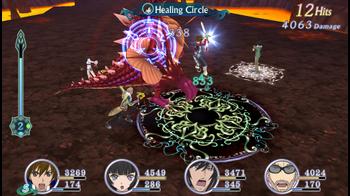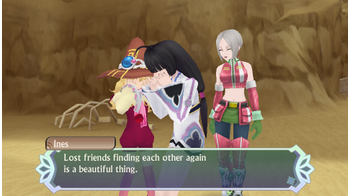
Tales of Hearts R Review
Bandai Namco’s Tales series of Japanese RPGs has had quite the year in 2014. With Tales of Symphonia Chronicles releasing early in the year and Tales of Xillia 2 hitting shelves only a few months ago, here comes Tales of Hearts R to wrap things up on PlayStation Vita.
As those familiar with the series would know, Tales of Hearts R is a party-based action JRPG. Combat occurs in real-time with the player having full control over one character’s movement while the rest of the four person party is guided by AI settings.
As with the other games in the series, you can move freely around a battlefield, stringing together series of normal attacks and special ‘arte’ attacks in order to vanquish the numerous enemy groups you will encounter along the course of the game.
At the game’s onset, however, it’s fairly clear that the combat in place is not as fluid as the series’ recent console brethren. The pace is slowed down and character movement is significantly more basic. Little things like side-steps are absent this time around, which lessens the importance of character positioning.
Instead, the game puts a small focus on proper guarding, which if timed well, will open up a chance for a counter attack. This results in a somewhat more clumsy experience than I expected, but the fundamental system is still serviceable here.
Unlike many of the more recent entries, combat is not engaged by running into an enemy icon on the field. It is instead initiated by random battles as you roam. This small but significant change can make traversal a bit more tedious than typical, as you can no longer easily avoid combat by avoiding enemy icons. You instead must use up consumable items to lower or eliminate the encounter rate for a (short) while, or just tough it out.
Each Tales game has a unique hook to its combat, and in Hearts R we find the Chase Link system. Once an enemy has taken a significant amount of damage, it can be launched around the battlefield, unable to attack or defend. This opens up the opportunity to unleash your best combo attacks, including a special finishing move. You can also perform dual finishers with another party member when Chase Link is active.
I personally found this mechanic to be largely uncreative and unsubstantial. Throughout combat, the player is always pressing various combinations in order to damage enemies, and having Chase Links appear largely randomly didn’t feel to truly add much to the flow of battle.
While Tales of Hearts R has several playable characters to choose from, playstyle variety is a bit lacking too. Due to the more simple control scheme, many characters play very similarly to each other – especially the physical attacking units. One of the things I most appreciated about this series in general was the opportunity to tinker with various combat styles and approaches. Here, however, despite switching characters, I found myself behaving the same way in battle with most of them.
Dungeons are mostly linear paths, with the occasional dead-end branch to a chest or a quick puzzle to solve. As I played through the game, I kept hoping the complexity of these areas would improve, but they managed to remain mostly streamlined up to the endgame. You mostly move from point A to point B without any thought, fighting battles as they come to you. On top of that, several times throughout the game, you have to revisit ‘Spiria’ dungeons that are essentially busywork locations to traverse a simple maze.
As the title might suggest, the storyline in Tales of Hearts R centers around love and the bond between friends, even more heavily than the genre typically does. Characters are shaped by their Spirias (hearts) and from that they can manifest weapons to wield (called Somas).
The more literal focus on the bonds between people and how it can empower our protagonists is hard to stomach at times, and treads a common narrative that is hard to take seriously. The writing is juvenile and the cast is about as cliché as you can get. You won’t find a compelling storyline here.
Lastly, the game performs well on the system, with short loading times and a solid framerate. While not necessarily a visual showcase, a bright color palette makes the game pleasant to look at. Sakuraba’s soundtrack is right in line with much of his previous work: functional, but not in any way memorable.
All in all, Tales of Hearts R is a serviceable RPG on the PlayStation Vita, but that’s about all it is. Generic but not broken, many aspects of the game fall short and nothing stands out. Perhaps this can be justified due its portable nature, but the experience remains unremarkable nonetheless.


